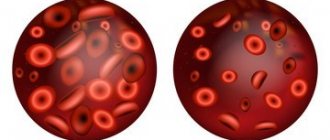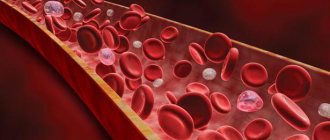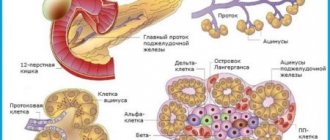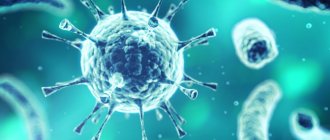Iron deficiency anemia in children develops due to a lack of iron reserves in the body. Most often, the disease manifests itself in young children and adolescents, as their body grows rapidly, and at the same time the need for iron increases.
A decrease in hemoglobin concentration in the circulating blood entails a number of negative consequences:
- trophic disorders in organs and tissues due to lack of oxygen in the blood;
- decreased immune defense and, as a result, an increased risk of infectious pathologies.
At the same time, laboratory tests show reduced numbers of hemoglobin and the number of red blood cells in a general blood test, and ferritin and iron in biochemical studies.
International classification
There is an International Classification of Diseases (ICD), currently this is the 10th revision of this classification. In accordance with it, iron deficiency anemia (IDA) is designated D50. When making a diagnosis, specialists must specify the type of anemia. The iron deficiency code is as follows ICD 10: D50.
According to statistics, the prevalence of iron deficiency anemia in children under three years of age is 40%, in adolescents - 30%, and in women during pregnancy - 44%.
Iron deficiency anemia in children Prevention
To prevent IDA, the American Academy of Pediatrics recommends the following:
- Healthy full-term babies up to 4 months have sufficient iron reserves in the body.
- After 4 months, if the baby is breastfed only, he needs iron supplements at a dosage of 1 mg/kg per day, due to the low iron content in breast milk - before introducing complementary foods.
- For mixed-fed babies, the recommendations are similar.
- Babies fed with adapted milk formulas receive enough iron from their food and do not require additional administration of iron-containing medications.
- Whole cow's milk is not recommended for children under one year of age.
- Children aged 6-12 months require 11 mg of iron daily, which they should get through their diet. Complementary foods should include red meat and iron-rich vegetables.
- Children 1-3 years old need 7 mg of iron per day, their diet must include red meat, vegetables rich in iron and fruits rich in ascorbic acid.
- All children born before term, who are breastfed or mixed fed, require the administration of iron-containing medications in doses of at least 2 mg/kg per day from 1 month of life until the introduction of complementary foods.
- And premature and low birth weight babies who are artificially fed should be fed with iron-fortified milk formulas.
Risk groups for IDA (USA Academy of Pediatrics)
- Children from socially disadvantaged families, low-income families.
- Premature or low birth weight babies.
- Children who are exclusively breastfed after 4 months of age without complementary feeding or taking iron supplements by the child.
- Children who are fed whole cow's milk or iron-poor foods for up to one year.
Additional risk factors
- Malnutrition, growth and weight retardation.
- Increased iron requirements due to the condition of the body.
Iron deficiency anemia in children Clinical observation
Dispensary observation of children and adolescents with IDA is carried out in our country for 1 year from the date of diagnosis.
The child’s well-being and general condition are monitored. A general blood test is monitored monthly, and after normalization of indicators - once every 3 months. Before removing a child from the dispensary, a general blood test is prescribed, which should be normal
Causes
The main factors that can cause iron deficiency anemia include:
- Perinatal factors - placental abruption and previa, large fetal weight, prematurity, umbilical cord ruptures, fetoplacental or feto-fetal transfusions.
- Lack of iron intake from outside - defects in feeding, the use of milk formulas not fortified with iron for feeding babies under one year old, late complementary feeding or vegetarianism of a nursing mother.
- Malabsorption syndrome (impaired absorption capacity of the intestine), as well as recurrent acute intestinal infections (AI) and acute respiratory viral infections, dysbacteriosis.
- Disorders of iron transport in the body, which include hypotransferrinemia and atransferrinemia.
- Blood loss, which can develop as a result of abnormalities in the development of the gastrointestinal tract, tumors or injuries.
- Intensive growth of the baby, especially with prematurity.
- Rickets suffered at an early age.
Symptoms
Iron deficiency anemia in children manifests itself in the form of various syndromes:
- Astheno-vegetative syndrome occurs when there is a lack of oxygen supply to organs and tissues (hypoxia). Such children experience muscle hypotonia and are lagging behind in physical development. The brain also suffers from hypoxia. This may manifest itself as tearfulness or irritability, they may lag behind in psychomotor development, and in severe cases, intellectual disability develops. During adolescence, such children experience frequent dizziness and even fainting and orthostatic collapse, and they also suffer from vegetative-vascular dystonia. Enuresis in young patients with anemia is common.
- Epithelial syndrome is characterized by changes in the skin, nails and hair. In this case, dry skin, brittle and striated nails, and hair loss are observed. Hyperkeratosis is observed on the knees and elbows. Small cracks may appear on the oral mucosa, this is the so-called angular stomatitis.
- Dyspeptic syndrome is manifested by decreased appetite, flatulence, constipation or diarrhea. Symptoms of dysphagia (difficulty swallowing food) may occur. In advanced cases, anorexia develops.
- Cardiovascular syndrome is manifested by shortness of breath, rapid heartbeat, hypotension, myocardial dystrophy and heart murmur.
- Hepatolienal syndrome develops gradually with severe iron deficiency anemia. Anemic children develop hepatosplenomegaly, a condition in which the spleen and liver become enlarged.
- Some children may experience geophagia or perverted appetite. In this condition, the child eats inedible objects, for example, soil, rubber, etc.
What should be the prevention?
Prevention of anemia involves eliminating the causes of the disease. Iron deficiency anemia will not develop if a pregnant woman or nursing mother eats rationally, maintains a healthy lifestyle and takes multivitamin and iron supplements. For older children, preventive measures are the same as for adults.
← Symptoms and consequences of anemia during pregnancy
Anemia in children: symptoms and treatment, disease prevention →
We recommend studying similar materials:
- 1. Autoimmune hemolytic anemia in children: what is missing and how it manifests itself
- 2. How to choose a diet based on your blood type: losing weight together
- 3. Causes and dangers of increased basophil levels in children
- 4. The level of basophils in adults has decreased: how to treat basophilia
- 5. Reasons for an increase or decrease in neutrophils in a blood test in children?
- 6. Norms for the content of neutrophils in the blood and what functions they perform
- 7. Normal bilirubin levels in newborns and children: reasons for the increase
Nervous system disorders in IDA
For young children, IDA is particularly dangerous in the area of development of the nervous system. ICD 10: D50 can provoke a delay not only in the child’s physical development, but also in mental development.
During the period of introducing complementary foods into an infant's diet, the child's body is especially susceptible to insufficient iron intake. This is the age range from 6 months to 2 years. Children of this age grow especially quickly. At this age, children are most often diagnosed with IDA (ICD 10: D50). The last phase of the brain development spurt coincides with exactly this age interval of the child. During this period, the baby's fine motor skills and cognitive abilities develop.
Iron deficiency in preschool children (3 to 6 years old) leads to decreased attention. The child is not able to recognize simple visual clues for solving problems, for example, he cannot compose a story by looking at pictures or describe the actions depicted in them.
Long-term anemia leads to brain hypoxia. First, the child develops weakness, absent-mindedness and increased fatigue even with minor exertion, then complaints of headaches often appear. The child constantly wants to sleep or, conversely, is too excited.
With ICD 10: D50, an increase in red blood cell agglutination often occurs; they stick together directly in the bloodstream. This can lead to vascular thrombosis of the brain, which may result in signs of softening of the brain matter, which is manifested by paralysis and paresis.
Clinical picture
Signs of iron deficiency anemia, especially in infants, depend on the severity of the disease. In most cases, pediatricians note the appearance of the following clinical symptoms:
- Paleness of the skin and mucous membrane.
- Increased fatigue. The child does not want to walk on his own for a long time, immediately begins to ask to be held, and avoids active games.
- Tearfulness, capriciousness.
- Low blood pressure, sometimes children complain of dizziness.
- Deterioration of hair and nails.
- Inflamed, painful cracks appear in the folds of the lips and between the phalanges of the fingers.
- Digestive disorders, belching, flatulence, changes in taste preferences, smell perception.
- In young children, there is a noticeable lag in psychological and physical development. Adolescents show signs such as decreased mental activity, memory and attention.
- Sometimes muscle pain occurs.
Iron deficiency anemia in a child is accompanied by a disruption of the immune system. Children are very susceptible to various viral infections, which are quickly complicated by bacterial inflammation. By listening to the heart, the doctor can distinguish murmurs specific to iron deficiency anemia.
IDA in pregnant women
Iron deficiency anemia develops quite often in pregnant women. Moreover, 9 out of 10 pregnant women suffer from ICD 10: D50. The daily iron requirement for non-pregnant women is 18-20 mg. But most women do not receive this norm with nutrition, therefore, when pregnancy occurs, the reserve of this element in the body is insufficient.
Considering the fact that during fetal development, iron reserves are consumed significantly, anemia by the beginning of the third trimester is observed in almost half of women.
The table below shows your iron requirements during pregnancy.
| Process | Iron consumption in mg |
| Increased metabolism and hemoglobin replenishment | 350-500 |
| Formation and growth of the placenta | 100-120 |
| Fetal nutrition and growth | 420-500 |
| Increased size of the uterus | 50-60 |
The body's reserve fund is used for these processes, but in most cases this is not enough, so pregnant women develop IDA of varying severity.
With a significant deficiency of this element during pregnancy, progressive hemic hypoxia develops and, as a result, secondary metabolic disorders occur. In addition, severe IDA can provoke the development of circulatory hypoxia, which leads to the development of a hypokinetic type of blood circulation and dystrophic changes in the myocardium.
Even a latent form of anemia during pregnancy leads to the risk of miscarriage, premature birth, weakened labor, or gestosis. With severe or prolonged anemia, placental function is impaired. This, in turn, leads to the development of IDA in newborns. Such children often experience delayed motor and mental development and decreased immunity, which leads to frequent infectious diseases.
During pregnancy, it is especially important to monitor hemoglobin levels. If necessary, the doctor with whom the woman is registered will prescribe iron supplements. All recommendations of a specialist must be followed; the health of the expectant mother and baby depends on this.
Iron deficiency anemia in children Treatment
Goals of treatment for IDA
- Eliminate the cause of the disease (adjust nutrition, identify and eliminate the source of blood loss).
- Replace the missing iron in the body.
Iron deficiency anemia in children Treatment principles
- Iron-containing medications are prescribed because It is impossible to compensate for the lack of iron in the body using other methods.
- Iron-containing medications are primarily used for internal use.
- Doses of iron-containing medications are selected individually, taking into account the patient’s age, weight and treatment plan.
- The duration of treatment should be for anemia of the first (mild) stage. - 3 months, for anemia of the second (middle) stage. 4.5 months, and for third (severe) degree anemia - six months.
- During treatment, iron reserves in the depot should be replenished, which can be determined by the normalization of serum ferritin levels.
- Mandatory monitoring of the effectiveness of treatment with iron-containing drugs is necessary.
In the Russian Federation, IDA therapy is carried out according to the “Iron Deficiency Anemia” Protocol approved by the Ministry of Health of Russia dated October 22, 2004.
In the treatment of IDA in children there are features that are taken into account in therapeutic protocols. For example, prescribing iron-containing salt medications to children under 3 years of age in dosages of 5-8 mg/kg body weight per day, as recommended by the protocol, leads to toxic effects in some children. Therefore, for children under 3 years of age the recommended daily dosage of iron-containing medications is 3 mg/kg, for children over 3 years of age - 5 mg/kg.
Iron deficiency anemia in children Oral medications
Iron-containing drugs for the treatment of IDA can be divided into ionic-salt (divalent) and drugs based on the hydroxide polymaltose complex (trivalent).
2-valent iron preparations include actiferrin, sorbifer, ferroplex, fenyuls.
Trivalent iron preparations based on polymaltose hydroxide complex include: maltofer, ferrum-lek, polymaltose iron, ferri.
Modern scientific research proves that the effect of 2x and 3x valentine iron preparations in the treatment of IDA is the same.
Side effects occur during IDA therapy with bivalent iron preparations
- Frequent overdoses and sometimes drug poisoning due to the body’s uncontrollability of passive absorption of iron.
- Reaction with other medications and food.
- A characteristic metallic taste in the mouth after taking the medicine.
- Brown or purple discoloration of the gums and tooth enamel, usually disappearing over time, in rare cases is persistent.
- High percentage of parents refusing treatment (up to a third of those who started treatment).
Ferric iron preparations based on polymaltose hydroxide complex do not have most side effects
- They are safe.
- There is no risk of overdose, intoxication, or poisoning.
- Does not stain gums and teeth.
- They do not have a metallic taste.
- Well tolerated.
- Do not interact with other medications and products.
- They have antioxidant properties.
- Patients are less likely to refuse treatment.
Iron deficiency anemia in children Medicines for parenteral use
Parenteral (intravenous and intramuscular) iron-containing medications are used when there are contraindications to the administration of iron-containing medications for internal use or they do not have an effect.
Parenteral iron-containing medications are needed for
- Severe forms of IDA (today they are rare, less than 3% of patients with anemia).
- Allergies to oral iron-containing medications.
- Ineffectiveness of iron-containing medications for oral administration.
- The presence of gastric or duodenal ulcers in children or gastrointestinal tract operations in the past.
- Chronic bowel disease in a patient (Crohn's disease, ulcerative colitis).
- Chronic kidney diseases (in the pre-dialysis and dialysis periods) if they are aggravated by anemia.
- Presence of contraindications to red blood cell transfusion.
- There is a need to quickly saturate the body with iron.
Intramuscular or intravenous iron supplements are usually given 1-3 times a week. When treating with parenteral iron-containing drugs, the total iron deficiency, which can be calculated using the Ganzoni formula, should not be exceeded.
General iron deficiency, mg = Patient's body weight, kg × (Hb (normal), g/l - Patient's Hb, g/l) × 0.24 + Iron depot, mg. Coefficient 0.24 = 0.0034 × 0.07 × 1000: iron content in Hb - approximately 0.34%; blood volume - 7% of body weight; 1000 - conversion of grams to milligrams. Iron depot in patients with body weight: less than 35 kg - 15 mg/kg, target Hb concentration - 130 g/l; more than 35 kg - 500 mg, target Hb concentration - 150 g/l.
This formula takes into account iron in the depot, which makes up more than a third of the total amount of iron in the body. A decrease in iron reserves in the depot can be determined by the amount of serum ferritin.
Local (burning, itching) and general (allergic) side effects are possible when iron is administered parenterally. When administering iron parenterally, monitoring of the patient, use of a test dose of the drug before starting therapy, and accurate calculation of the dose of the drug are required.
In order for treatment with parenteral iron-containing drugs to become safe and effective for a child, the following treatment principles should be followed:
- Use modern parenteral iron-containing medications with low toxicity, without possible anaphylactic reactions that pose a threat to the baby’s life.
- Determine the general iron deficiency in the child’s body before starting treatment.
- Stop therapy after the general iron deficiency in the body is replenished in order to avoid iron oversaturation, which is dangerous for the child.
- Follow the technique of intramuscular injections and intravenous infusions of iron-containing drugs.
- Strictly follow the instructions for parenteral iron preparations if it is recommended to administer a test dose before starting therapy.
- Therapy should be carried out within the range of safe doses, since the side effects of parenteral iron-containing drugs are dose-dependent.
Criteria for the effectiveness of iron deficiency therapy for iron deficiency anemia
- Reticulocyte reaction: by the end of the first, beginning of the second week from the start of therapy with iron-containing drugs, the number of reticulocytes increases by 2-3% or 20-30‰ when compared with their number before treatment.
- An increase in Hb level by the end of a month of therapy by 10 g/l and hematocrit by 3% when compared with the initial figures before treatment.
- Relief of anemia within 1-1.5 months from the start of treatment.
- Replenishment of iron deficiency in tissues in the depot after 3-6 months from the start of therapy, which can be determined by normalization of the level of SF (more than 30 ng/ml).
Reasons for the ineffectiveness of iron deficiency anemia therapy
- Incorrect diagnosis of iron deficiency anemia in children.
- Inadequate dose of iron-containing medications.
- Insufficient duration of IDA therapy.
- Failure to follow doctor's orders by the child's parents.
- The child has difficulty absorbing iron from the gastrointestinal tract.
- Child intolerance to the chosen medication.
If the diagnosis of IDA is made correctly, then the effect of iron therapy will definitely be. If there is no reticulocyte reaction, which characterizes the first effect of treatment, and there is no increase in Hb level by 10 g/l and hematocrit by 3% after a month of therapy, then you need to stop taking the medication and consider the diagnosis, because there is a possibility that child - not WAITING.
Resistance of IDA to therapy with iron-containing drugs is often caused by an incorrectly selected dose or anemia has nothing to do with iron deficiency.
A new form of IDA called iron-refractory iron deficiency anemia (IRIDA) has recently been described. It is inherited in an autosomal recessive manner. IRIDA therapy with oral iron medications is ineffective, but some effect is obtained with parenteral iron medications.
Red blood cell transfusion for IDA
In IDA, in most cases, there are no indications for red blood cell transfusions. Even in severe cases, IDA can be successfully treated with oral, intramuscular, or intravenous iron medications. The risks of transfusion of red blood cells to combat IDA significantly outweigh the benefits.
Diagnostics
Laboratory diagnostics consists of examining a general and biochemical blood test. The results of a general blood test for ICD 10: D50 indicate low hemoglobin (the norms corresponding to the child’s age can be found below) and a decrease in MCH (average hemoglobin content in red blood cells) and MCV (average red blood cell volume).
A biochemical blood test with ICD 10: D 50 shows a low ferritin content in the blood serum and a low iron level. In latent forms of anemia, iron in the blood plasma may be normal or at the lower limit of normal. That is why, for a correct diagnosis of IDA, an indicator such as ferritin must be examined - this is the iron reserve in the body.
In addition, other possible causes of IDA need to be investigated. The cause may be malabsorption, for example, due to celiac disease, a disease associated with digestive disorders and damage to the villi of the small intestine due to intolerance to gluten (a protein found in cereals and other foods).
Normal hemoglobin levels in newborns according to age
| Child's age (number of days lived) | Hemoglobin norm (g/l) |
| 1 | 190-230 |
| 2 | 180-220 |
| 3 | 185-230 |
| 4 | 183-225 |
| 5 | 175-220 |
| 6 | 174-210 |
| 7 | 173-215 |
| 8 | 170-210 |
| 9 | 170-210 |
| 10-15 | 168-205 |
Further, until the age of three months, hemoglobin continues to decrease. This is the norm. By three months, hemoglobin levels reach a physiological minimum. In children of this age, the hemoglobin level can drop to 90 g/l. If hemoglobin does not drop below this figure, then treatment is not required.
Then, gradually, hemoglobin numbers begin to rise and by six months, normally this figure should correspond to 110-120 g/l. But with intensive growth during this period, some children develop ICD 10: D50 due to increased consumption of oxygen and, accordingly, iron by tissues. In this case, you need to contact a pediatrician who will prescribe treatment.
Provoking factors
Anemia can be caused either by blood loss or nutritional factors. Blood loss is divided into birth and postpartum. Childbirth is associated with blood loss during childbirth, placental abruption, untimely cutting of the umbilical cord, and birth injuries. Postpartum are divided into internal (endogenous) and external (exogenous).
Endogenous causes include hemolytic destruction of red blood cells, impaired hemoglobin formation, and bone marrow pathologies.
Exogenous causes include low iron reserve at the time of birth, Ferrum deficiency in breast milk, late use of complementary foods, switching to low-quality infant formula, early feeding of cow's or goat's milk.
Important! You should know that the need for iron in children born with high birth weight, as well as premature babies, is increased.
Iron deficiency is the main cause of anemia
Children may lose iron through nosebleeds, trauma, or surgery. Blood loss is possible when blood clotting is impaired as a result of a hereditary disease or improper use of certain medications. Children suffering from allergic diseases lose a lot of iron, so their need for the element is increased.
Important! If the absorption of Ferrum from the intestines is disrupted, anemia occurs. Some chronic diseases can lead to anemia.
An imbalance of water-soluble B vitamins, a number of microelements (Mg, Co, Cu), and poor hygienic living conditions can also cause anemia.
We also recommend studying this topic:
Causes of hereditary sickle cell anemia
Treatment
If the cause of anemia turns out to be celiac disease, then treatment consists of eliminating foods containing gluten from the patient’s diet.
Children suffering from IDA are recommended to eat foods rich in iron. In addition, as a rule, treatment is carried out using iron-containing drugs:
- "Citron";
- "Niferex".
These drugs are tolerated more easily by the child's body than others and they do not stain the teeth. The drug “Folic acid” can also be used to treat ICD 10: D50. The dosage is prescribed by the pediatrician individually in accordance with the child’s age and body weight.
For treatment to be successful, you must continue taking iron supplements for at least three months. After this, tests are performed and the result of treatment is assessed.
Diet for iron deficiency anemia
When diagnosed with ICD 10: D50, treatment is supplemented with special nutrition. The diet should contain foods rich in iron. For young children, these should be special nutritional mixtures fortified with iron. For older children, complementary foods should include veal, poultry, beef, cottage cheese and chicken egg whites.
Food for preschool and school-age children should contain a large amount of proteins. In addition to meat products, offal (liver) and fish, as well as homemade cottage cheese, are added to the diet.
In addition, it is necessary to eat foods rich in vitamins B and C. These can be fruits and berries, for example, black currants and rose hips, as well as citrus fruits. It is beneficial to add sweet bell peppers, cabbage, lettuce, green onions and cabbage to your daily diet.
Food restrictions
Successful treatment is impossible without some restrictions. When creating a daily menu for a child suffering from ICD 10: D50, you should remember that some foods can interfere with the absorption of iron in the body. These products include tea and coffee. Considering that coffee is generally contraindicated for young children, it remains to limit tea. It can be consumed, for example, only for breakfast, and for the rest of the day you can drink fortified juices or water.
You should limit foods containing calcium, polyphenols, oxalates, and phytic acid. These substances interfere with the absorption of iron.
Calcium is found in dairy products, so you should not overuse them, especially if iron supplements are prescribed. Oxalates are found in spinach, beets, and strawberries - these foods should be used in moderation in the diet. Polyphenols are found in coffee and tea, and in some herbal teas. Phytic acid is found in walnuts, beans, whole grains and bran. But it should be borne in mind that if legumes are soaked for 12 hours before cooking, then negative consequences can be avoided.
A disease such as IDA or ICD 10: D50 is a serious diagnosis and it can have very negative consequences. Its treatment is lengthy and must be treated responsibly. This disease is especially dangerous for pregnant women and young children. Therefore, if a doctor has diagnosed IDA, you should carefully consider all the treatment specialist’s recommendations.











